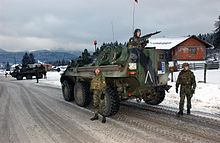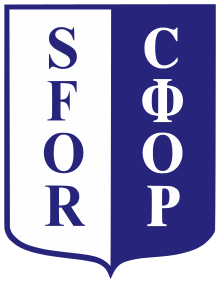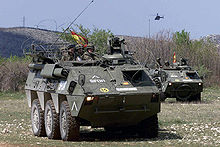SFOR
| SFOR | |
|---|---|
| operation area |
|
| German name | Stabilization forces |
| English name | Stabilization Force |
| French name | Force de stabilization |
| Spanish name | Fuerza de Estabilización |
| Based on UN resolution | 1174 (June 15, 1998) |
| Other UN resolutions | 1088 (December 12 1996) |
| Type of mission | Peace mission |
| Beginning | December 21, 1996 as Operation Joint Guard from June 20, 1998 as Operation Joint Forge |
| The End | December 2, 2004 |
| management | NATO |
| Operating strength (min.) | 7,000 (end of 2004) |
| Operating strength (max.) | 30,000 |
| Location of the operational area |

|

The Stabilization Force ( SFOR to German "stabilization forces") was the NATO - protection force for Bosnia and Herzegovina . Their task was to prevent hostilities, stabilize peace and normalize conditions in the country after the Bosnian war .
Attendees
All of the then 16 NATO member states took part. The then non-NATO countries Albania , Argentina , Australia , Bulgaria , Estonia , Finland , Ireland , Jordan , Latvia , Lithuania , Morocco , New Zealand , Austria , Poland , Romania , Russia , Sweden , Slovakia , Slovenia , South Africa , the Czech Republic The Republic , Ukraine and Hungary also provided troops or staff to varying degrees.
history
By resolution 1088 of the United Nations Security Council of December 12, 1996, the mandate of the previous Implementation Force (IFOR) was initially transferred to SFOR for 18 months and later extended several times. SFOR was deployed as part of Operation Joint Guard on the basis of the 1995 Dayton Treaty .
On June 15, 1998, the United Nations Security Council passed resolution 1174, a follow-up SFOR operation. The mandate was given for a further 12 months. First there was the plan to rename the SFOR in DFOR ( Deterrence Force ) and give it an indefinite mandate. But the name SFOR remained.
Operation Joint Forge began on June 20, 1998, and for the first time a special multinational unit was deployed to improve capabilities to support police forces and governmental and non-governmental organizations in promoting public safety.
The SFOR mandate finally ended on December 2, 2004 and was replaced by the Operation Althea program under the protection of EUFOR troops. The NATO Headquarters Sarajevo (NHQSa) remained in Sarajevo to support the International Criminal Tribunal for the former Yugoslavia and to act as a liaison with EUFOR.
Involvement of the Bundeswehr
See also: GECONSFOR
On June 19, 1998, the German Bundestag voted in favor of ongoing military security for the peace process with the participation of the Bundeswehr . Of 576 votes cast, 528 MPs voted yes; 37 with no and 11 abstentions.
The German contribution to SFOR was initially mainly based in the Multinational Division South-East (MND SE). This division consisted mainly of units from Germany, France, Italy and Spain under French leadership and comprised around 9,400 soldiers at the end of 1999.
The German Army Contingent SFOR was stationed in the Rajlovac field camp and was directly subordinate to the Army Command in Koblenz . Until the end of 2004, the Bundeswehr also operated the Filipovići subcamp near Foča , which, however, was closed.
As part of the Multinational Brigade Center within MND SE, the German-French deployment contingent DFGFA (Franco-German Group / Groupement Franco-Allemand) was a core element. Germany provided the DFGFA, a surveillance association consisting of tank reconnaissance and infantry forces, as well as staff, security, command and control forces.
The 14 air force tornado fighter jets made available to NATO in Piacenza in northern Italy were subordinate to the AIRSOUTH (Allied Air Forces Southern Europe) headquarters in Naples . The mission was conducted by the NATO command post of the 5th Allied Tactical Air Force (5th ATAF), the later Combined Air Operations Center in Vicenza (later: CAOC 5 in Poggio Renatico) ( Ferrara province ).
The navy's maritime patrols carried out limited missions under NATO command and were subject to operational control by the NAVSOUTH (Allied Naval Forces Southern Europe) headquarters in Naples.
For their participation in the mission, the German soldiers received the Bundeswehr Medal and the NATO Medal , which was awarded to all SFOR soldiers.
Involvement of the armed forces
On December 12, 1995, the Austrian Council of Ministers decided to send 300 soldiers to a transport unit.
The deployment of the unit called AUSLOG / IFOR (Austrian Logistics / Implementation Force) was initially limited to one year and began in January 1996. Until 2000, the Austrian units, together with Belgian, Greek and Luxembourg soldiers, were stationed at Visoko , then followed relocation of the unit and integration into the German GECON logistics unit in the Rajlovac camp .
The first Austrian participation in SFOR ended on June 6, 2000, with a few officers still being made available in Sarajevo . To this end, Austria committed 2,000 soldiers to the EU reaction force .
On June 27, 2004, AUCON 1 / SFOR was deployed in accordance with a Council of Ministers decision . AUCON 1 / SFOR was the military short name of the Austrian company-strong infantry contingent. It comprised a total of 135 people and consisted of an infantry company with supplementary leadership, special operations, information gathering and supply elements. They were stationed in the BUTMIR camp near Sarajevo.
“These forces, specially trained for their task, were on duty for the next six months as part of a Multinational Specialized Unit (MSU) in Bosnia-Herzegovina. In the operational area, the contingent was part of an Italian-led battalion. One of the main tasks was to support the SFOR troops and the civil authorities in maintaining public order and security. "
AUCON's contract with SFOR ended with the start of the EUFOR mission on December 1, 2004.
assignment
SFOR's mission:
- Ensure general freedom of movement
- Inspections of properties belonging to the former parties to the conflict
- Investigation of unauthorized deployments
- Control of military actions
- Liaison with UNHCR (United Nations Refugee Agency), IPTF (International Police) and OSCE (Organization for Security and Cooperation in Europe)
- Support of international organizations
SFOR, to which around 1,800 German soldiers (including 51 women) belonged as part of GECONSFOR , showed its presence through checkpoints as well as weapon collection and search operations (so-called door-to-door operations ) and worked closely with various UN organizations (so-called CIMIC ) to rebuild the country together. Their total strength was about 5,000 men. The total strength of the peacekeeping force was about 30,000 men.
Structure and locations
The headquarters of SFOR (HQ SFOR / NATO) in Bosnia and Herzegovina was initially housed in a former hotel complex in the suburb of Ilidža outside of Sarajevo , later the move was made to the former so-called "airfield" next to Camp Butmir near the airport. 42 different nations worked together here. The Stabilization Force Support Command (SFOR SC) was stationed in Zagreb.
A sub-area and an important part of SFOR was the CJPOTF ( Combined Joint Psychological Operation Task Force , formerly Combined Joint Information Campaign Task Force (CJICTF)), in Germany comparable to the operational information of the Bundeswehr. From her the conviction of the population u. a. influenced by magazines (youth magazine MIRKO and Herald of Progress ), radio (Radio MIR) and television programs (TV-SFOR) in the spirit of the mission.
Multinational Divisions 1996–2002
Initially, the SFOR operational area was divided into three areas of responsibility:
- Multinational Division North (MND N), in the north and northeast under the leadership of a commander (COMDIV) of the United States with headquarters in Tuzla ,
- Multinational Division South-West (MND SW), in the west with headquarters in Banja Luka . Great Britain provided all commanders, except for the period 09/2001 - 09/2002, which was taken over by a Dutch major general.
- Multinational Division South-East (MND SE) based in Mostar . All commanders came from France.
Multinational Brigades January 2003 – April 2004
In January 2003 there was a restructuring in 10 battle groups, divided into three multinational brigades and were subordinate to the supreme command of the SFOR commander, ( COMSFOR; Commander SFOR ):
- Multinational Brigade North (MNB-N) with headquarters in Tuzla. A commander (COMBrig) from the United States took over the command during the entire time.
- Multinational Brigade South-East (MNB-SE) with headquarters in Mostar. The commanders provided Germany, France, Italy and Spain.
- Multinational Brigade North-West (MNB-NW) with headquarters in Banja Luka. The commanders were provided by Great Britain and Canada.
Multinational Task Forces May – December 2004
The Task Forces (TF), each with 1,800 to 2,000 soldiers, were under the supreme command of the SFOR commander ( COMSFOR; Commander SFOR ).
- Multinational Task Force North (MNTF-N) with staff in Tuzla,
- Multinational Task Force South-East (MNTF-SE) with staff in Mostar,
- Multinational Task Force North-West (MNTF-NW) with staff in Banja Luka.
In addition, there were around 1,000 other soldiers as forces for the theater of war (Theater Troops).
Web links
- Official SFOR website
- Map: SFOR stationing locations in 1997
- Michael Pesendorfer: IFOR - SFOR - EUFOR. In: Troop service, episode 282, issue 2/2005. Austria's Armed Forces, accessed on December 9, 2009 .
- Guide to the history of Bosnia-Herzegovina. Center for Military History and Social Sciences of the Bundeswehr, accessed on August 25, 2020 .
- The operational command of the Bundeswehr. Retrieved August 25, 2020 .




